Shopping: To Delhi, with love
The not-so-secret guide to shopping in India’s colourful capital.

The not-so-secret guide to shopping in India’s colourful capital. PHOTO: AYESHA MIR, DESIGN BY MUNIRA ABBAS
My friend’s reprimand comes surprisingly swift. They say “bhayya”, not bhai, she scolds. “You’re asking to get swindled — they’ll know you’re not from here.”
We are at Dilli Haat, a popular open-air shopping and food square that houses beautiful Indian fabric, costume jewelry and affordable gastronomic delights. The stalls of souvenirs and paintings are colourful and attractive, but it’s the flavour-loaded Lucknowi kebabs I’m really after. I’m told by Dilliwalas that the biryani is a must-have, but I refuse to believe it can come close to our delightfully fragrant Sindhi version (Bandar kya jaane adrak ka swaad?). Still, how would I know if I haven’t tried it?
It’s my first morning in Delhi, the darling of Bollywood movie lyrics and Pakistani brides-to-be, and although I am here on a short visit (three days), the to-do list is tall in size and ambition. The foodie and explorer in me are excited to absorb tourist attractions and cuisine simultaneously (I have a vision of myself eating Haldiram’s Kaju Katli as I stand before the Jamae Masjid in Old Delhi — wah!). But friends, family and a few colleagues have cajoled me into shopping with elaborate wish lists.
So between a stress-busting massage at the hotel spa and a visit to the Hazrat Nizamuddin Auliya (RA) shrine, my friend and I squeeze in what we hope is going be a quick stop at Dilli Haat. As fate would have it, the 15-minute auto rickshaw ride from central Asoka Road to the busy market area allows the wind to take liberties with my freshly blow-dried hair. But despite a bumpy ride and some blurry selfies we have for mementos, the structure, feel and sharp sounds of the metropolis leave us energised.
Back at the block-printed sari stall, I am still wincing at the possibility of being ripped off. I think of how deeply my mother will frown when she discovers I’ve made a bad buy, and quickly shake off the mental image.
With my just-above-ankle length Elan lawn outfit and freshly uttered request punctuated with the word “bhai”, I might as well have worn my I heart Karachi t-shirt. But I try again, this time with the “bhayya” and a more uncompromising tone. He tells me it’s for INR1,500 (roughly Rs3,000). I immediately apply my bargaining formula: Offered Price Divided by Two.
We are at it for about 10 minutes before he realises I won’t budge. So he decides to dangle bait. “Yeh dekho,” he coaxes, holding up an exquisite printed silk sari. “Alag hi cheez hai.”
I’m sold. The sari he is holding is a soft white canvas hosting a garden of printed peacock feathers. The motifs dance like flames, with tones of the Turkish evil-eye. It’s soft and smooth and a sure-shot winner for my mother. He says it’s for INR7,000. We settle at INR5,000 for both this and the block-print sari, he packs them into neat, rectangular cloth bags and we forge ahead.

Thrilled with the purchase, my friend and I delve deeper into the Haat, making greedy stops at almost every shop in sight. Some items are discouragingly expensive, while others (such as costume jewelry) are budget-friendly and too irresistible to give up. At one such stall, I pick up two necklaces and a carved cuff that I make a mental note to show off at fashion week in October.
As our lifafa of money grows leaner with each sojourn, my friend and I make a pact to ‘look [at] but not touch’ anything else for the next 10 minutes. A few paces into our deal, our resolve is tested by a lazy-looking shop assistant. Bablu’s shop number 96 is like any other in the Haat, but three wide, eye-popping dupattas hanging on a wire bring water to our mouths as quick as a bowl of piping hot Channa Batura served with fluffy round puris. We have stumbled upon kantha — Bengali running stitch embroidery which employs trees of life, birds of paradise as well as fish, elephants and even tigers to conjure a jungle daydream. As we go through elegant saris, long dupattas and shorter stoles, we pour breathlessly over vibrant shades of fiber, weaving pictures of gardens and even everyday activities. Some have portly fish, others stick figures. My favourite is one with large and small peacocks, some bending their necks in shy submission. The stitch is so flat and perfect that the creased effect gives the material an added vintage feel.
We pick up five kantha saris and a few dupattas, and after much persuading and coercing Bablu into giving an India-Pakistan friendship discount and a Bablu-Bablu discount (I told him we have a friend we called Bablu, but he didn’t quite fall for it), the grouchy shopkeeper settles at about INR7,000 each for the lighter saris and about INR4,500 each for the dupattas. Our wallets nearly empty and our faces flushed from the Delhi mid-day sun, we skip the biryani and kebabs and go for chilled Naryal ka Pani, dossas and gol guppas. It is time to say goodbye to the Haat and visit the busy shrine of Nizamuddin Auliya (RA).
Chandni Chowk for chikan kari
Purani Dilli is unadulterated, raw India. The noise pollution, organised chaos and cultural opulence are a lot like those from Kajol’s neighbourhood from Kabhi Khushi Kabhi Gham. I am excited about my visit to Chandni Chowk, the Saddar-like market famed for saris, chikan kari and trimmings. The very alliteration is a taste of how fun and quixotic the place is.
My guide today is a Multan-born, Delhi-based journalist who is a foodie at heart. We take a cycle rickshaw for INR50 near the Jain Mandir to venture deeper into the market, only to discover two minutes later that there is an obstruction in the form of a large cement truck blocking our intended destination, the Mirza Ghalib Memorial.
After five minutes of deliberation, my companion and I decide to go by foot. And so, with my sleeveless tie-dyed maxi dress clutched around my knees, I wade through a muck of water and cement to cross over to the other side, where the Parathe Wali Gali, Sari Market and Haldiram await me. I’m perfectly amenable to walking, because the stares I received while we sat in a slower-than-snail rickshaw were far too embarrassing. At one point, while our rickshaw was stuck in a jam on a particularly packed street, the man riding the rickshaw behind me was close enough to lean in and say, “Hello baby, how are you?” in a tone that sent us into fits of laughter. I vow to buy a dupatta at the first stall I see, so I can cover up my arms and put an end to the gawking.

The Ghalib Museum is dimly lit and empty, but Haldiram’s bustling shop in the middle of Chandi Chowk is the best thing that happened to the sweet tooth. From bhujia sev in packets to fresh soan papdi, rasgullas and a Bengali mithai I can’t recall the name for but has a chum chum texture, there is something sweet or namkeen to cater to every palette. I quickly snap up a few boxes of the cherished kaju katli for relatives back home, while my friend gifts me a box of Karachi halwa (delicious little squares with almonds) and we are off to the Parathe Wale Gali, where we devour oily mooli, aaloo and cheese parathas served with a thaali of aalo bhujiya, pickled onions and chanas. As if the garma garam parathas were not good enough, the hole-in-the-wall eatery we were at even had a signed and framed picture of Ranbir Kapoor’s visit to the modest dhaba.

The sari market in Chandni Chowk is full of the typically Indian saris you see in TV soaps. Intricate gold borders and paisley and lotus motifs are common, but each brightly coloured piece calls out to you like you’ve never seen anything like it before. Lucky for my wallet, my friend refuses to let me stop anywhere. So I drool and dream. I don’t have much money left anyway, just about INR15,000 which I need to spend on Lucknowi kurtas for my mother as well as the kajal and Fair & Lovely for men colleagues have requested back home. Back at the hotel, my Pakistani friends show me heavily worked chikan kari and mukesh peshwazes — a stunning but steep purchase at INR36,000 each available at Chandni Chowk. Oh, and if you don’t have enough cash, remember that the clever shopkeepers accept dollars and credit cards — there really is no escaping it.
Lajpat Nagar for Lucknowi Kurtas
In south Delhi, the Lajpat Nagar Metro Station is crowded at 7pm. I have never seen so many people throng a metro, but even in the swelling crowds, commuters of all ages make organized lines to buzz themselves past the turnstile, have their bags scanned and wait for the metro. As I get out, it is dark, and my first instinct, being a woman in the “rape capital of the world”, is fear. But as I catch sight of the busy Lajpat Nagar market on my way down from the metro steps, I feel less alone. Young men and women are strolling around the lanes of Lajpat Nagar I, II, III and IV. The kurtas I am after are in the cloth markets of I and II. I run into the first shop I see and describe the cotton kurtas. As always, the salesperson pulls out the kurtas of the finest, most heavily worked and expensive variety, as if to mentally prepare me for the kind of spending that is coming. He successfully sells me unstitched kurtas in mostly white, with some in a powder blue or baby pink. For five shalwar kameez sets I pay INR9,000.
Khan Market for meena work
The U-shaped Khan Market, bang in the heart of the city, is a fun place to hang out if you want to grab a bite to eat or shop at local and international retail stores. I thoroughly enjoy an evening at a restaurant named Blanco’s near a FabIndia outlet, where they serve sushi and spicy Mexican pizza among many other savoury and dessert items. FabIndia itself, however, doesn’t entice me. The retail store, which employs rural dwellers to make handicrafts, clothing and home accessories, has some beautiful things, but is far too expensive for someone who has done a market survey. An average cotton sari at FabIndia will be priced at INR6,000. I would much rather buy two kantha stoles (about INR2,500 each) for that amount.
What Khan Market does have plenty of is lots of little shops, much like Zainab Market in Karachi, where you can buy button-down tops, floral printed jeans and meena balis. I find a particularly charming little shop selling the meena earrings, and I pick up in four different colours for INR200 each.
As I prepare to return home, I feel exhilarated to have made a trip to India to appreciate its rich work, something that I know many women in Pakistan would also like to undertake. I learned that Indian women are crazy about our surma just like we are about Lakme kajal. They would spend thrice the amount to buy our lawn as we would for their chikan kari. They die for our Sindhi biryani and chicken rolls as we do for their thaalis and dossas. The obsession is mutual, if only traveling across the border were easier.
I return with an empty wallet but a full heart.
1 Dull gold necklace with ruby red and emerald green beads. Bought from Dilli Haat for INR350
2 Engraved camel bone cuff with a green stone, another favourite from Dilli Haat, INR500
3 Dull gold dangling necklace with black stone motif
4 A peacock print silk sari with a turquoise and gold paisley border. Priced at about INR4,000
5 Black and maroon kantha sari with an intricate floral border. INR7,000
6 Meena hoop earrings for INR150 each, available in different colours and sizes
7 Natural dyes in a box. Designer Asif Sheikh only uses them as he feels they keep the colour soft
8 (see right) A kantha sari with birds of paradise motifs
Correction: An earlier version of this story incorrectly stated that kantha embroidery is from Bangladesh.
Published in The Express Tribune, Sunday Magazine, September 29th, 2013.

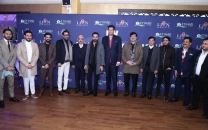
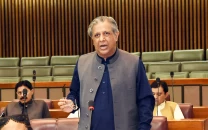





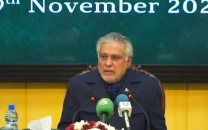
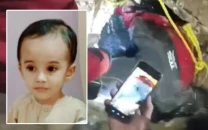
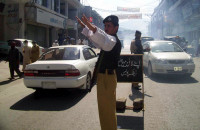

1729471601-0/image-(8)1729471601-0-208x130.webp)






COMMENTS
Comments are moderated and generally will be posted if they are on-topic and not abusive.
For more information, please see our Comments FAQ